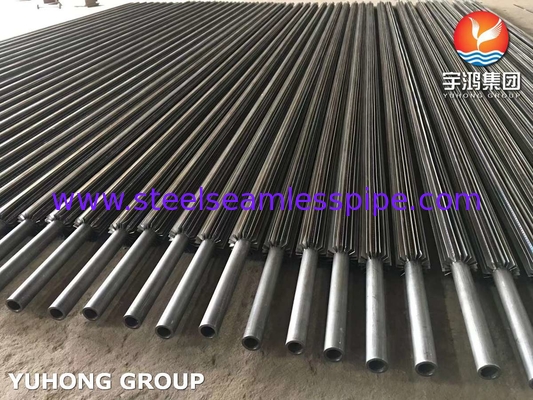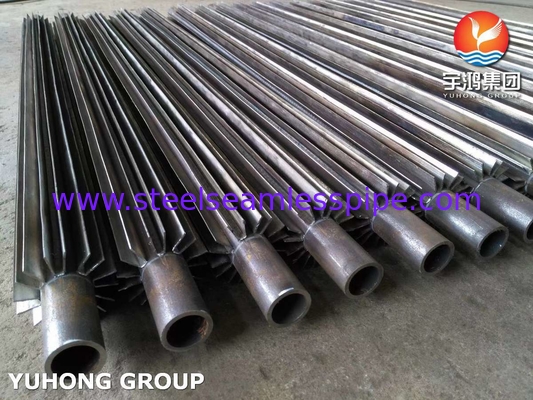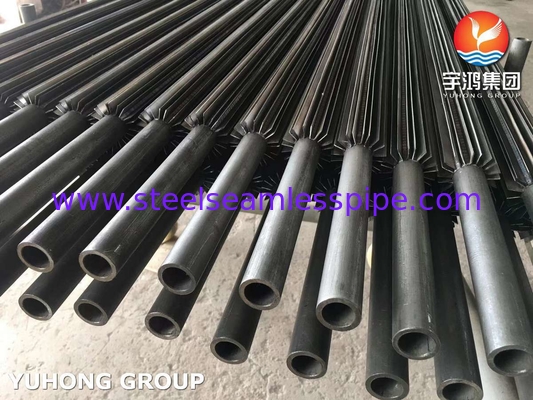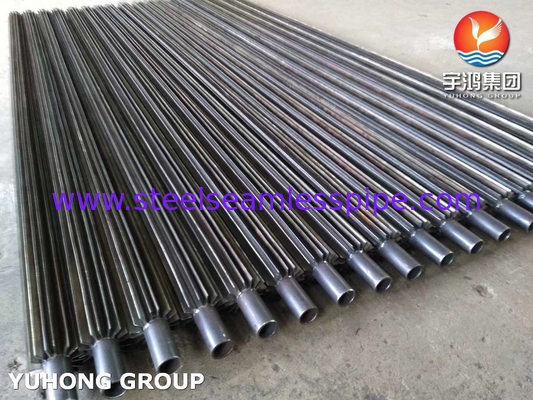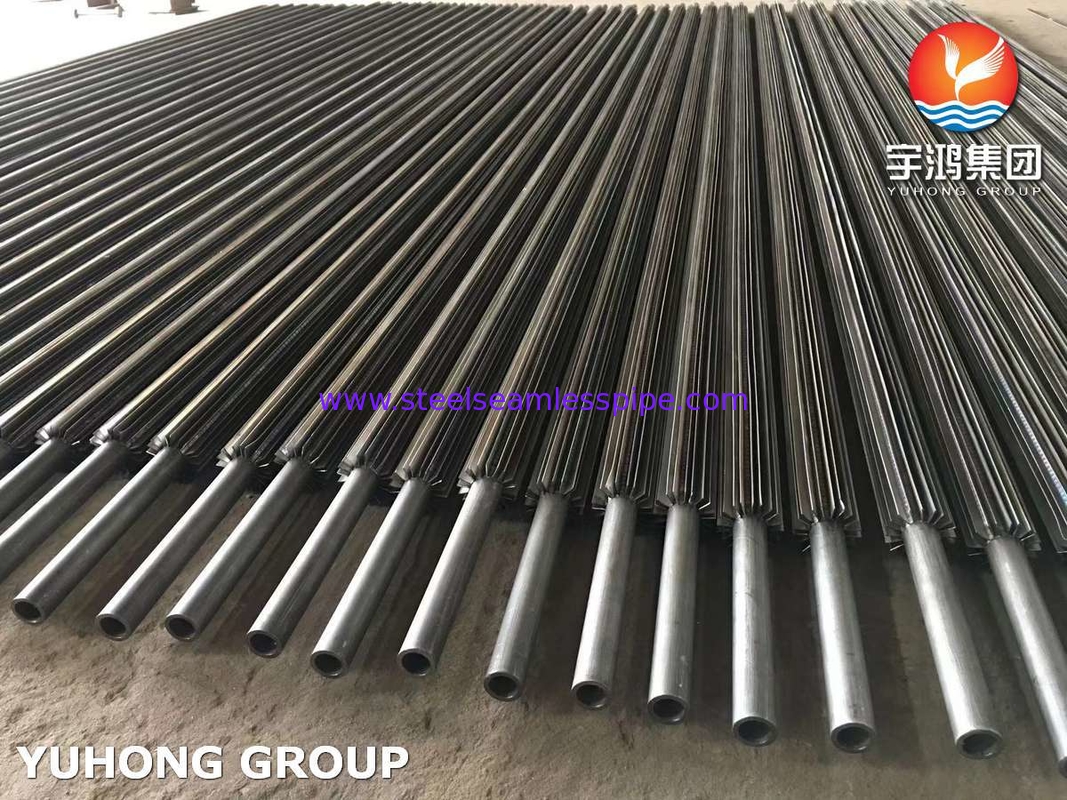ASTM SA210 Gr A1 Längsflossenröhre mit Kohlenstoffstahlflossenröhre
Ein Längsflossenrohr ist eine Art hocheffizientes Wärmeübertragungselement.mit einer Breite von mehr als 20 mm, jedoch nicht mehr als 30 mmDer Kernwert liegt darin, die Wärmeübertragungsfläche außerhalb des Rohres um mehrere bis Dutzende Male zu erweitern (das Flossenverhältnis kann 5~20 mal erreichen).
Diese Konstruktion löst speziell das Problem des Effizienzengpässes des Wärmeaustauschs zwischen Gas (wie Luft, Rauchgas) und Flüssigkeit im Rohr (Wasser, Dampf, Kältemittel usw.).Aufgrund des extrem niedrigen Wärmeübertragungskoeffizienten auf der Gasseite, wird es häufig zum dominierenden Faktor für den Wärmewiderstand des Systems; die Flosse durchdringt die Gasgrenzschicht tief, indem sie die Wärmeübertragungsfläche verlängert,und nutzt die Störungseffekte der Flossenkante auf den Luftstrom, um den thermischen Widerstand auf der Gasseite deutlich zu reduzieren, so daß die Gesamtwärmeübertragungseffizienz im Vergleich zum nackten Rohr um 2 bis 10 mal erhöht werden kann.
Zuverlässige Fertigung ist der Schlüssel zur Erreichung seiner Leistung, die hauptsächlich auf Verfahren wie Hochfrequenz-Widerstandsschweißen, integrierte Extrusion (wie Aluminiumrohr) oder Löten beruht. These processes ensure that the connection interface between the fin and the base tube has high thermal conductivity (reducing contact thermal resistance) and sufficient mechanical strength to withstand thermal stress and vibration under working conditions.
Bei der Konstruktion von Längsflossenröhren ist es notwendig, die Flossenparameter (Höhe,Abstand) um ein Gleichgewicht zwischen der Maximierung der Wärmeübertragung und der Steuerung des Gasstromwiderstands (Druckabfall) zu findenGleichzeitig müssen sowohl die Auswahl der Materialien als auch die besonderen Arbeitsbedingungen berücksichtigt werden.die Auswahl korrosionsbeständiger Materialien (z. B. ND-Stahl oder Beschichtung) in Umgebungen, die anfällig für Tau-Korrosion sind, wie z. B. schwefelhaltiges Rauchgas, unter Berücksichtigung der Staubbeständigkeit bei staubigen Gasen (z. B. durch größere Flossenräume) und der Gewährleistung der strukturellen Zuverlässigkeit unter Vibrationsbedingungen.
Aufgrund seiner hervorragenden Wärmeübertragung und KompaktheitLängsflossenröhren werden in verschiedenen Szenarien, in denen der Wärmeaustausch zwischen Gas und Flüssigkeit dominiert und hohe Platz- oder Effizienzanforderungen bestehen, weit verbreitetZu den typischen Anwendungen gehören: Abwärmerückgewinnungsgeräte (Ökonomizer, Luftvorheizer) in Kesselsystemen, Prozessgaskühlgeräte/Heizgeräte in der petrochemischen Industrie,Verdampfer/Kondensatoren in KühlsystemenDies ist eine Schlüsseltechnologie, um kompakte Geräte und eine effiziente Energieverwertung zu erreichen.
Beziehung zwischen Flossenrichtung und Luftstrom
| TYPE |
Flossenrichtung |
Luftstromrichtung |
Konvektionsmechanismus |
| Langflächige Flossenröhren |
Flossen sind parallel zur Rohr-Achse |
Gasströme parallel zu den Flossen |
Luftstrom fließt entlang der Flossenlänge mit geringen Störungen |
| Horizontale Flossenröhre |
Flossen sind senkrecht zur Rohr-Achse (spiralförmig/ringförmig) |
Gasströme senkrecht auf die Flossen |
Der Luftstrom wird durch die Flossen zum Drehen gezwungen/gestört, was zu starken Störungen führt |
Vergleich von Wärmeübertragungsleistung und Widerstand
| Eigenschaften |
Längsflossenröhre |
Horizontale Flossenröhre |
| Wärmeübertragungskoeffizient |
Mittlere (schwache Störung des Luftstroms) |
Höher (Wirbel zerstört die Grenzschicht) |
| Wärmeübertragungsfläche |
Flossenverhältnis 5 ~ 20 mal |
Flossenverhältnis 10 ~ 30 mal (kann höher sein) |
| Luftstromwiderstand |
Unterer (Gleichstromkanal) |
Wesentlich höher (Wirbelenergieverbrauch) |
| Staubschutz |
Ausgezeichnet (ein gerader Kanal kann nicht leicht von Staub blockiert werden) |
Schlechte Funktionsweise (Spiral-Rohr kann leicht durch Staub verstopft werden) |
Anwendung
Energie und Energie
Heizkessel, Luftvorheizer, Abwärmekessel für Gasturbinen
Petrochemie
Prozessgasheizung/Kühler, Reaktionsproduktkondensator, Schmierölkühlung
Klimatisierung und Kühlung
Verdunstungskondensator, Luftkühler-Spule, Außenwärmepumpe
Industrieabfallwärmerückgewinnung
Trocknungsgeräte, Keramiköfen, Glasschmelzofen
Transportmaschinen und -geräte
Dieselmotoren, mit einem Zwischenkühler, Hydraulikölradiator


 Ihre Nachricht muss zwischen 20 und 3.000 Zeichen enthalten!
Ihre Nachricht muss zwischen 20 und 3.000 Zeichen enthalten! Bitte überprüfen Sie Ihre E-Mail!
Bitte überprüfen Sie Ihre E-Mail!  Ihre Nachricht muss zwischen 20 und 3.000 Zeichen enthalten!
Ihre Nachricht muss zwischen 20 und 3.000 Zeichen enthalten! Bitte überprüfen Sie Ihre E-Mail!
Bitte überprüfen Sie Ihre E-Mail! 
